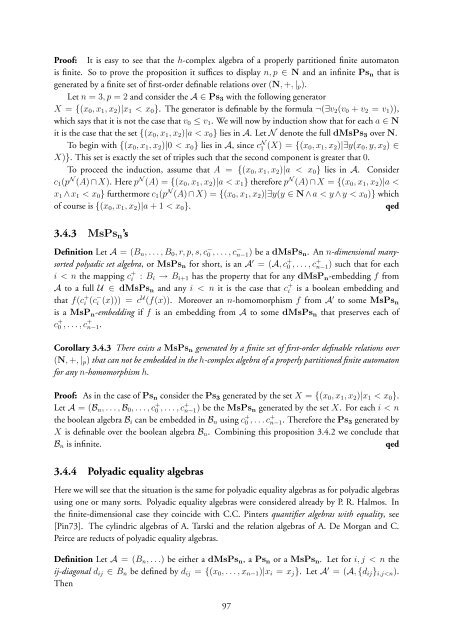On the methods of mechanical non-theorems (latest version)
On the methods of mechanical non-theorems (latest version)
On the methods of mechanical non-theorems (latest version)
Create successful ePaper yourself
Turn your PDF publications into a flip-book with our unique Google optimized e-Paper software.
Pro<strong>of</strong>: It is easy to see that <strong>the</strong> h-complex algebra <strong>of</strong> a properly partitioned finite automaton<br />
is finite. So to prove <strong>the</strong> proposition it suffices to display n, p ∈ N and an infinite Ps n that is<br />
generated by a finite set <strong>of</strong> first-order definable relations over (N, +, | p ).<br />
Let n = 3, p = 2 and consider <strong>the</strong> A ∈ Ps 3 with <strong>the</strong> following generator<br />
X = {(x 0 , x 1 , x 2 )|x 1 < x 0 }. The generator is definable by <strong>the</strong> formula ¬(∃v 2 (v 0 + v 2 = v 1 )),<br />
which says that it is not <strong>the</strong> case that v 0 ≤ v 1 . We will now by induction show that for each a ∈ N<br />
it is <strong>the</strong> case that <strong>the</strong> set {(x 0 , x 1 , x 2 )|a < x 0 } lies in A. Let N denote <strong>the</strong> full dMsPs 3 over N.<br />
To begin with {(x 0 , x 1 , x 2 )|0 < x 0 } lies in A, since c N 1 (X) = {(x 0 , x 1 , x 2 )|∃y(x 0 , y, x 2 ) ∈<br />
X)}. This set is exactly <strong>the</strong> set <strong>of</strong> triples such that <strong>the</strong> second component is greater that 0.<br />
To proceed <strong>the</strong> induction, assume that A = {(x 0 , x 1 , x 2 )|a < x 0 } lies in A. Consider<br />
c 1 (p N (A) ∩ X). Here p N (A) = {(x 0 , x 1 , x 2 )|a < x 1 } <strong>the</strong>refore p N (A) ∩ X = {(x 0 , x 1 , x 2 )|a <<br />
x 1 ∧ x 1 < x 0 } fur<strong>the</strong>rmore c 1 (p N (A) ∩ X) = {(x 0 , x 1 , x 2 )|∃y(y ∈ N ∧ a < y ∧ y < x 0 )} which<br />
<strong>of</strong> course is {(x 0 , x 1 , x 2 )|a + 1 < x 0 }.<br />
qed<br />
3.4.3 MsPs n ’s<br />
Definition Let A = (B n , . . . , B 0 , r, p, s, c − 0 , . . . , c − n−1) be a dMsPs n . An n-dimensional manysorted<br />
polyadic set algebra, or MsPs n for short, is an A ′ = (A, c + 0 , . . . , c + n−1) such that for each<br />
i < n <strong>the</strong> mapping c + i : B i → B i+1 has <strong>the</strong> property that for any dMsP n -embedding f from<br />
A to a full U ∈ dMsPs n and any i < n it is <strong>the</strong> case that c + i is a boolean embedding and<br />
that f(c + i (c − i (x))) = c U (f(x)). Moreover an n-homomorphism f from A ′ to some MsPs n<br />
is a MsP n -embedding if f is an embedding from A to some dMsPs n that preserves each <strong>of</strong><br />
c + 0 , . . . , c + n−1.<br />
Corollary 3.4.3 There exists a MsPs n generated by a finite set <strong>of</strong> first-order definable relations over<br />
(N, +, | p ) that can not be embedded in <strong>the</strong> h-complex algebra <strong>of</strong> a properly partitioned finite automaton<br />
for any n-homomorphism h.<br />
Pro<strong>of</strong>: As in <strong>the</strong> case <strong>of</strong> Ps n consider <strong>the</strong> Ps 3 generated by <strong>the</strong> set X = {(x 0 , x 1 , x 2 )|x 1 < x 0 }.<br />
Let A = (B n , . . . , B 0 , . . . , c + 0 , . . . , c + n−1) be <strong>the</strong> MsPs n generated by <strong>the</strong> set X. For each i < n<br />
<strong>the</strong> boolean algebra B i can be embedded in B n using c + 0 , . . . c + n−1. Therefore <strong>the</strong> Ps 3 generated by<br />
X is definable over <strong>the</strong> boolean algebra B n . Combining this proposition 3.4.2 we conclude that<br />
B n is infinite.<br />
qed<br />
3.4.4 Polyadic equality algebras<br />
Here we will see that <strong>the</strong> situation is <strong>the</strong> same for polyadic equality algebras as for polyadic algebras<br />
using one or many sorts. Polyadic equality algebras were considered already by P. R. Halmos. In<br />
<strong>the</strong> finite-dimensional case <strong>the</strong>y coincide with C.C. Pinters quantifier algebras with equality, see<br />
[Pin73]. The cylindric algebras <strong>of</strong> A. Tarski and <strong>the</strong> relation algebras <strong>of</strong> A. De Morgan and C.<br />
Peirce are reducts <strong>of</strong> polyadic equality algebras.<br />
Definition Let A = (B n , . . .) be ei<strong>the</strong>r a dMsPs n , a Ps n or a MsPs n . Let for i, j < n <strong>the</strong><br />
ij-diagonal d ij ∈ B n be defined by d ij = {(x 0 , . . . , x n−1 )|x i = x j }. Let A ′ = (A, {d ij } i,j
















